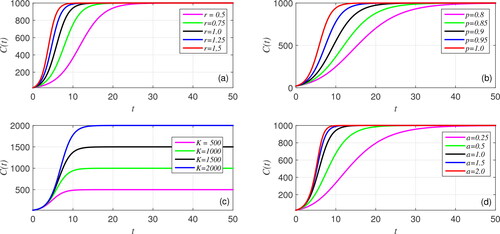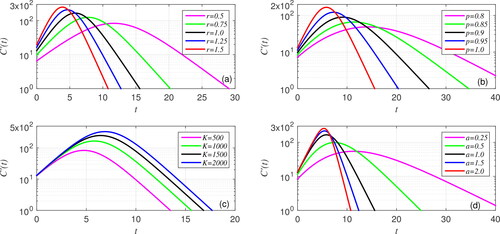Figures & data
Figure 3. The cumulative number of cases C(t) obtained by the Caputo fractional-order generalized Richards model (left-panel) and the Atangana-Baleanu in the Caputo sense (ABC) fractional-order generalized Richards model (right-panel) with parameter values (a,b) (c,d)
(e,f)
and (g,h)
The arrow shows increasing values of
and 1.0.
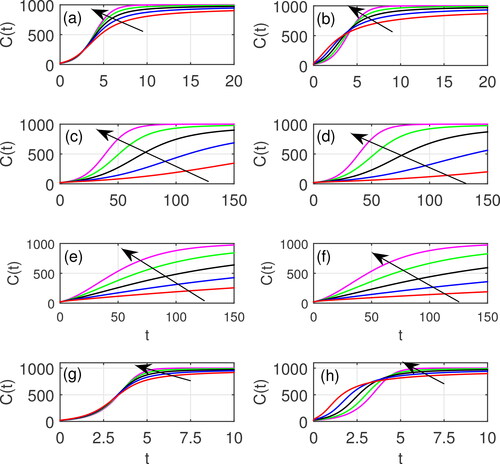
Figure 4. The corresponding daily new cases obtained by the Caputo fractional-order generalized Richards model (left-panel) and the Atangana-Baleanu in the Caputo sense (ABC) fractional-order generalized Richards model (right-panel) with parameter values (a,b)
(c,d)
(e,f)
and (g,h)
The arrow shows increasing values of
and 1.0.

Figure 5. Cumulative number of COVID-19 cases (left-panel) and daily new cases of COVID-19 (right-panel) in East Java Province, Indonesia.
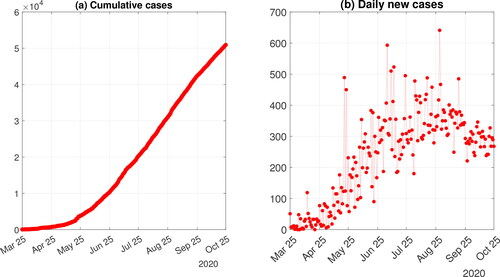
Figure 6. (a–f) Numerical solutions of the fitted GCFRM Equation(3)(3)
(3) compared to the confirmed COVID-19 data from east java. In the left panel, the fitted curves C(t) of the GCFRM Equation(3)
(3)
(3) using three different data periods: namely (a) March 25 – May 24, 2020 (61 d), (c) march 25 – Jul 24, 2020 (122 d) and (e) march 25 – Oct 21, 2020 (211 d), are compared to the cumulative confirmed cases; while the right panels show the comparison between the corresponding fitted
which are calculated numerically and the confirmed new daily cases.
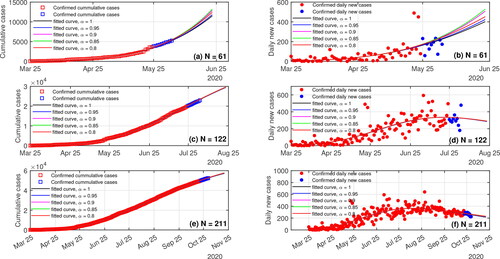
Figure 7. (a–f) Numerical solutions of the fitted GABCFRM Equation(7)(7)
(7) compared to the confirmed COVID-19 data from east java. In the left panel, the fitted curves C(t) of the GABCFRM Equation(7)
(7)
(7) using three different data periods: namely (a) March 25 – May 24, 2020 (61 d), (c) march 25 – Jul 24, 2020 (122 d) and (e) march 25 – Oct 21, 2020 (211 d), are compared to the cumulative confirmed cases; while the right panels show the comparison between the corresponding fitted
which are calculated numerically and the confirmed new daily cases.

Table 1. Estimated value of parameter based on the GCFRM Equation(3)(3)
(3) for different value of α. Notice that α = 1 corresponds to the first order GRM Equation(1)
(1)
(1) .
Table 2. Estimated value of parameter based on the GABCFRM Equation(7)(7)
(7) for different value of α. Notice that α = 1 corresponds to the first order GRM Equation(1)
(1)
(1) .
Table 3. Coefficient of determination for the calibration of cumulative number of cases.
Table 4. RMSE of the calibrating of cumulative number of cases.
Table 5. RMSE of the 10-day forecast of cumulative number of cases.
Table 6. RMSE of the calibrating of daily new cases.
Table 7. RMSE of the 10-day forecast of daily new cases.

